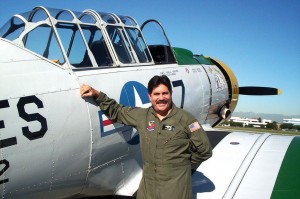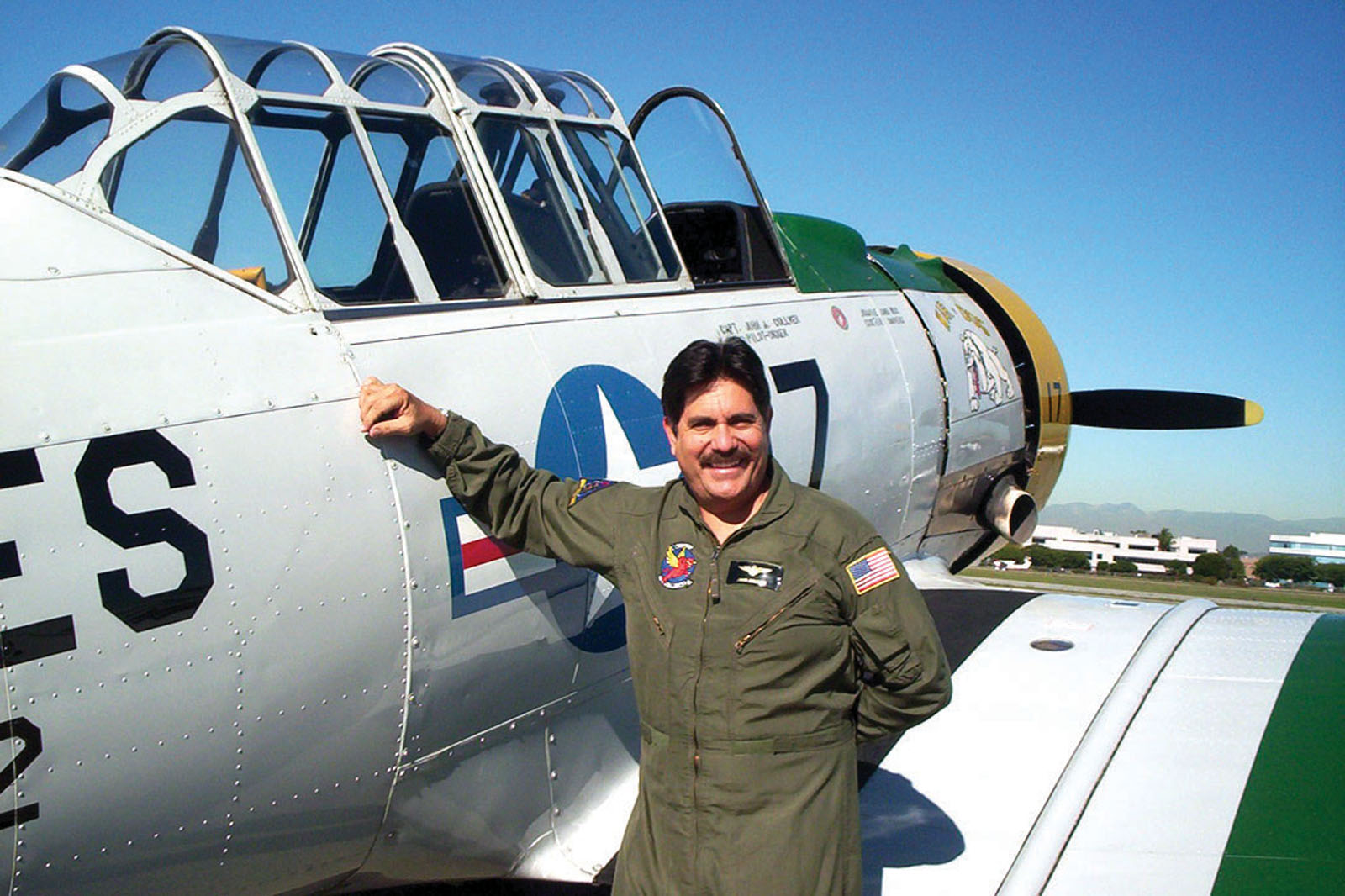By Fred
I first met her one morning when she was just a little over 5 years old, and I never really forgot what we did that day. I didn’t see her again for more than 43 years. I’ve seen her only a few times since then, and I’m pleased each time to see how gracefully she’s aged. Today I had a date to see her again.

John Collver flies his SNJ-5 “War Dog” in aerobatic performances 15 to 20 times a year at air shows along the West Coast.
“She” is SNJ-5, serial number 90917, a World War II advanced trainer that performs at air shows in the western United States, and is now known as “War Dog.” My Navy pilot’s log book shows that I flew her in flight training on Feb. 5, 1950. The solo cross-country flight was from Pensacola to New Orleans and back. That was five years before her present owner and aerobatic pilot, John A. Collver, was born!
On this particular day, I was flying to meet with John at Zamperini Field, where he had “War Dog” tied down. I was going to interview him about being an aerobatic pilot on the air-show circuit. Ron Millman was going to fly my friend, Lee Auger, and me to Torrance in his beautiful little Grumman Tiger.
After several days of strong Santa Ana winds, common in the Los Angeles area this time of year, the day was perfect for flying. With no noticeable wind, the air couldn’t have been clearer, and the typical smog and haze had blown away. Lee drove us to Whiteman Airport, where Ron had his Tiger ready to go. Ron slid the canopy to the rear, Lee climbed in the back, and I took the right seat.
In just a few minutes, we were cleared for takeoff from Runway 12. Lifting off at 11:45 a.m., we climbed out at 700 feet per minute, at 75 knots, toward a westerly heading. With plenty of time to get to Torrance, I took the controls and followed the north end of the crystal clear but bumpy San Fernando Valley to Chatsworth, then turned south to fly just west of my home in West Hills and Lee’s home in Woodland Hills.
We flew through a notch in the Santa Monica Mountains, reaching the smooth Pacific Ocean between Malibu and Topanga Beach. Los Angeles to the east, south to Palos Verdes, Long Beach and even Catalina Island, 23 miles off shore, were all clearly visible. As Ron handled the necessary radio reports, we turned left and flew southeast at 3,500 feet. We approached the busy visual flight rules “corridor” by flying directly over Santa Monica Airport, then Los Angeles International Airport.
The air was smooth as glass, and on our right, the sun glistened off the Pacific Ocean. Ahead over Palos Verdes, we could see the small white Sanyo blimp, heading for its base at Long Beach Airport. We spotted Zamperini Field easily, and Ron took the controls and made a left-hand approach to a perfect landing at 11:45, on 3,000-foot Runway 29L.
We parked near “War Dog,” with its bright yellow nose and shiny chrome spinner. Built in November 1944, “War Dog” is now 61 years old, and has about 1,000 hours on its tenth stock Pratt & Whitney Wasp radial 600-hp engine. Major inspections are performed throughout the year, with a qualified FAA inspector performing quarterly checks.
In a few minutes, John Collver drove up with Marianne, a pilot he’s teaching aerobatics. Collver, 50, started flying at the age of 13 at Torrance Airport, as it was then known. With a total pilot time of more than 14,000 hours, he’s flown aircraft from turboprops and jets to the Goodyear blimp. His pilot licenses include commercial, certified flight instructor, instruments, low altitude aerobatic waiver, limited operations for high-performance aircraft and an air transport rating. He’s type-rated in Beechcraft 1900s and King Airs.

Our pilot, Ron Millman, flew his four-place Grumman Tiger to Zamperini Field in Torrance. There, I interviewed John Collver.
As a corporate pilot for Northrop Grumman, he flew propjets, Gulfstreams, a Lear 35 and a Rockwell Sabreliner, until his retirement from corporate flying about 10 years ago.
John has spent 15 years building his aerobatic business. Although he’s a member of the International Council of Air Shows, formed in 1968, he says he basically sells himself.
“Some of the big air shows, like Miramar, Edwards Air Force Base, Point Mugu, and San Francisco Fleet Week, are booked a year in advance, usually at the conclusion of an air show,” he said. “Then I firm them up at the ICAS convention in December and throughout the year.”
For eight years, John was the backup pace safety pilot at the Reno National Championship Air Races and Air Show.
“I also do air show safety evaluation as a designee for the air-show industry,” he said. “People come to me to renew their aerobatic low-level waivers. After a lot of ground school, they fly at a certain altitude while I stand along the aerobatic box. Also, they can learn air-show flying from me.”
John normally performs 15 to 20 shows a year, but sometimes performs 30.
“I’m a West Coast guy,” he explains. “I’ve flown everything from Seattle to San Diego.”
John, who is presently looking for sponsors, says a typical show day starts in the early morning with a briefing on the schedule.
“You might be put anywhere in the air-show time frame,” John says. “Then you pre-flight your plane and go over any squawks with the crew chief.”
Besides problems that might be encountered, weather is also a factor in whether or not to fly. On standby throughout the day, the performers usually wait in an air-conditioned mobile command post. They’re hydrated and given food while they wait for their time slot.
According to an ICAS 2004 survey, more than 250 air shows take place yearly in the U.S. and Canada, with over 10,000 performances. Warbird aerobatic demonstrations are third in popularity, following major jet teams and solo tactical demos, such as the A-10. Next are the smaller Pitts and Extra 300. Also, not generally known, air shows are the second most popular spectator sport, exceeded only by professional football.
John says other aerobatic performers are “like family.”
“It’s nice to see them every year at air show sites, and at our ICAS convention meetings in December,” he said.
The flight back to Whiteman Airport took longer than the flight to Zamperini Field. Ron took off at 1:15 p.m. from 29R, and circled out over the ocean to gain altitude before flying the corridor up the coast. As we circled, we could see up the coast, south, well beyond Long Beach to Huntington Beach, before evidence of ground haze. What a terrific, clear day, and so smooth! I took the controls as we approached 4,500 feet and began following the northwest direction of the coastline, through the LAX corridor and over Santa Monica Airport.
As I flew over the Santa Monica Mountains, the entire San Fernando Valley was laid out like a carpet before us. West of Lee’s home, near the intersection of the Ventura Freeway and Valley Circle Boulevard, I picked up Platt Avenue heading north. There, just beyond Victory Boulevard, was Platt Village, where more than 60 of us meet every Monday morning for our “Wings Over Wendy’s” gathering. This was truly “wings over Wendy’s!”
Simi Valley was clearly visible ahead as Ron took the controls and found and circled the home of a relative. We then did some more sightseeing. I took the controls as we headed back to the San Fernando Valley. Although we were flying at a relatively low altitude over Simi Valley, we could see the tall buildings of Century City and downtown Los Angeles, more than 35 miles away.
Ron took over and landed at Whiteman Airport at 2:30 p.m., where he fueled and hangared his Tiger. We then all had a pleasant late lunch on the patio at Rocky’s Cafe. As George Peppard used to say on “The A-Team,” “I love it when a plan comes all together.”
To contact John Collver, call 310-539-3640, fax 310-325-7223 or email him at johnlomita@aol.com.











